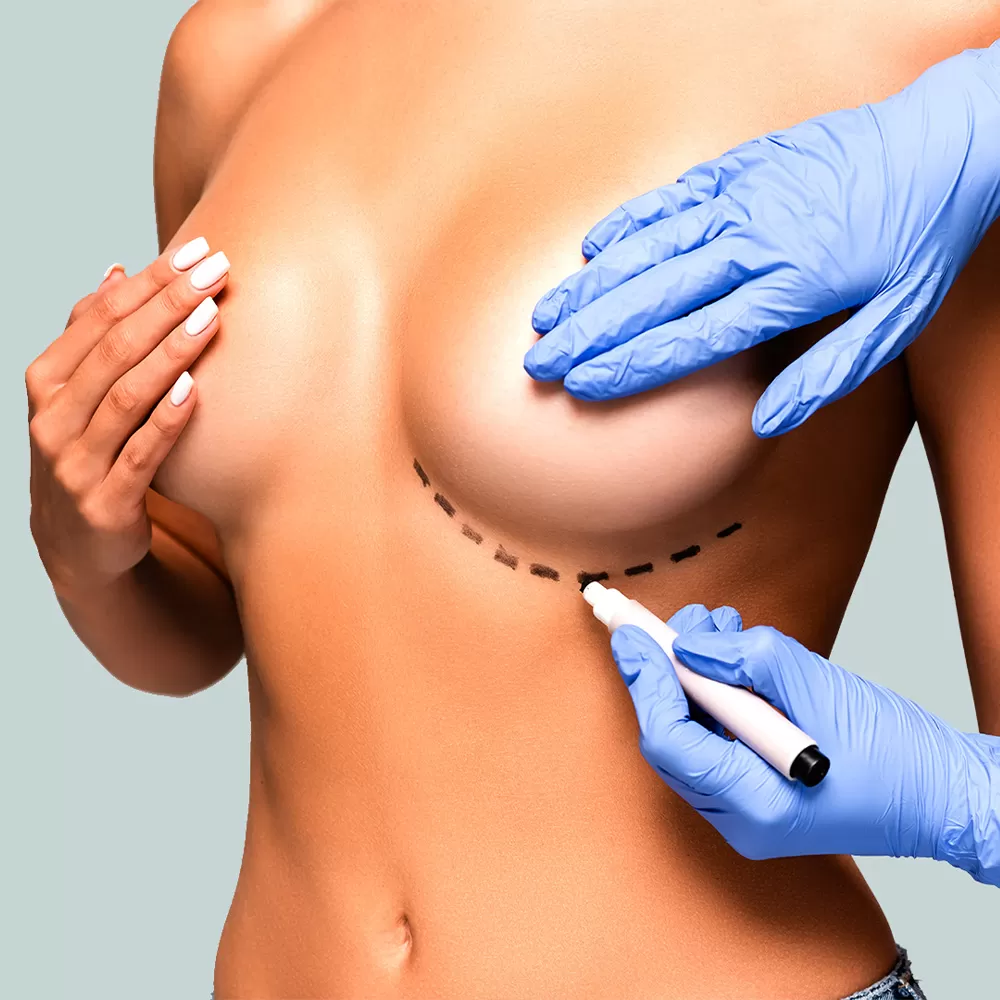
Breast sagging or ptosis is common after weight loss, as volume and elasticity of the breast tissue and skin are lost. With the loss of body fat, the skin and breast tissue become loose and stretched, giving a deflated and saggy appearance to the breasts, which is particularly more evident in women having massive weight loss, because the skin and tissue cannot recover completely.
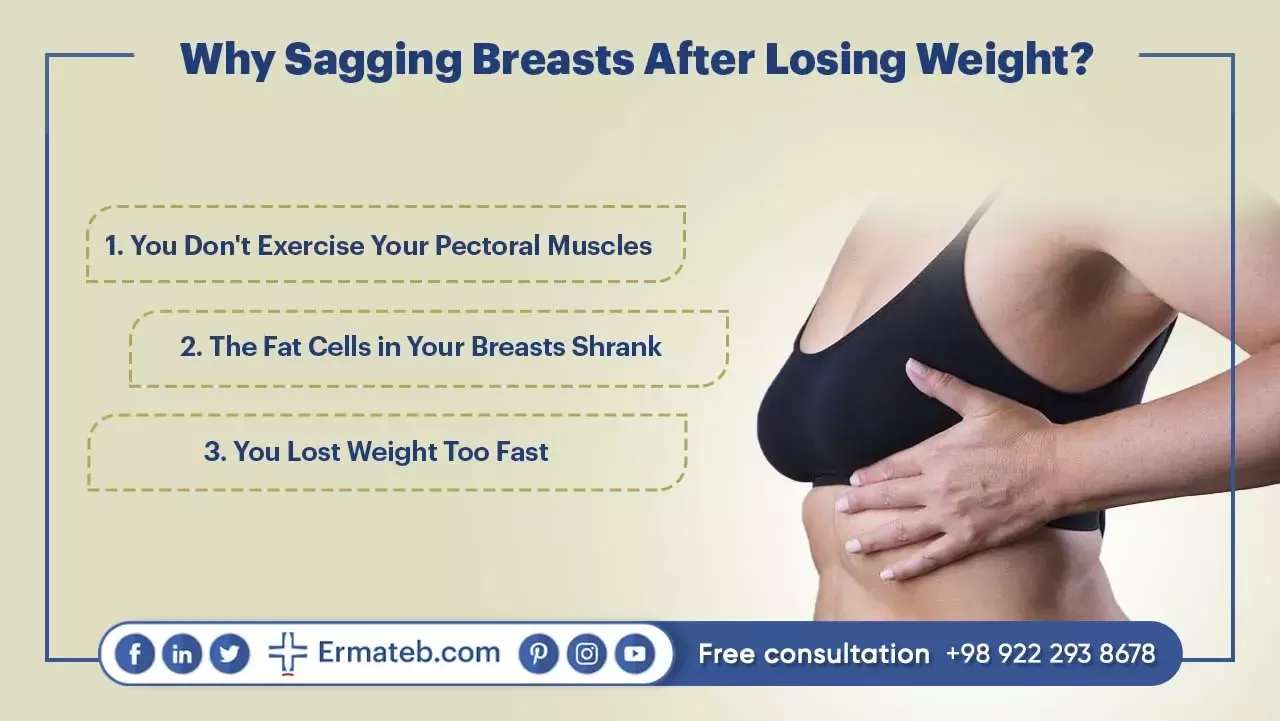
Weight fluctuation is one of the causes of droopy breasts, typically resulting from mass weight loss. There are a few reasons breasts may sag after weight loss, some of which are as follows:
Some people may do some work out to tone their muscles and build endurance when they are losing weight. However, many forget about pectoral muscles below their breasts.
Fat cells within the breast tissue expand when gaining weight and shrink when losing weight. The sagging or shrinking after weight loss may be more noticeable for those who have more fat and dense breasts.
Rapid weight loss is one of the common causes of decreased skin elasticity, and the breast is especially prone to these changes.
Too quick weight loss can lead to several problems, such as nutrient deficiencies, dehydration, fatigue, and weakness in addition to wrinkled breast skin. The resulting droopy breasts are associated with the loss of elastin and collagen, which keep the breasts firm and perky.
Thus, it's important lose weight gradually to allow the proteins in your body to adjust and make your breasts less likely to sag.

Sagging and deflated breasts can lead to dissatisfaction in many women, making them uncomfortable in their own skin. Fortunately, there are a variety of treatments available to help recover the shape, volume, and overall appearance of the breasts, some of which are discussed in this article.
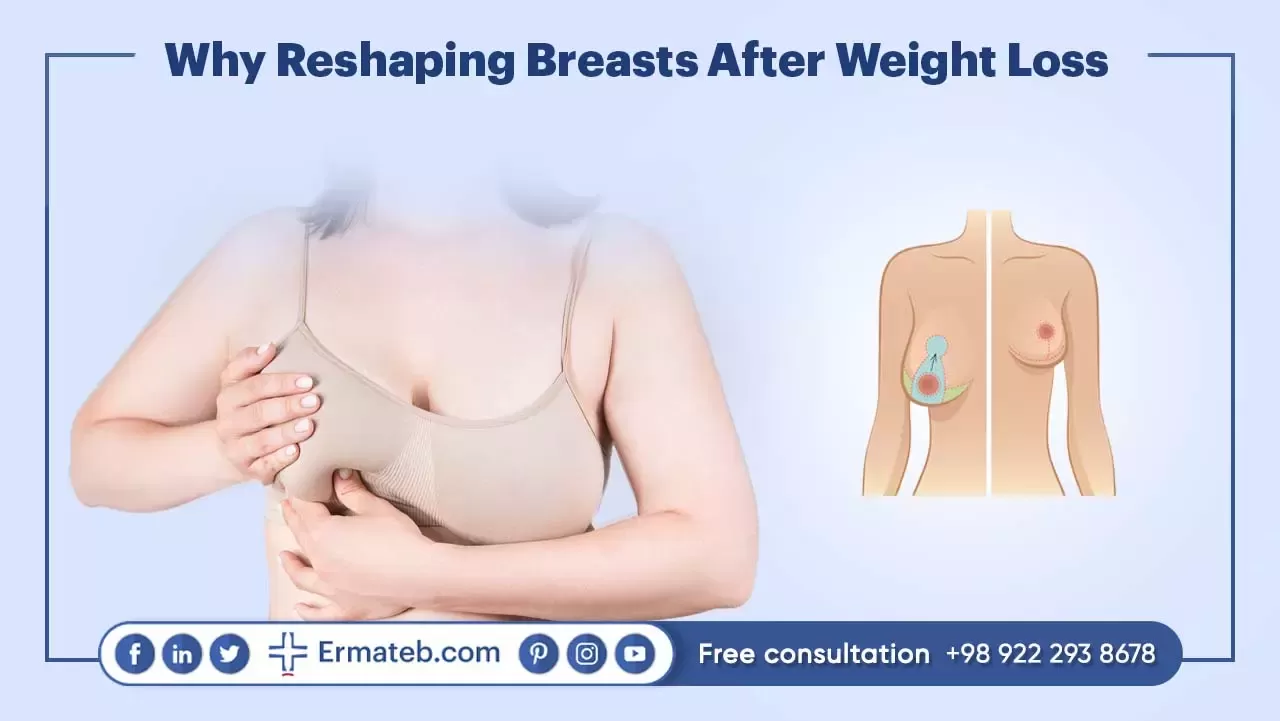
Enhancing breast size and shape helps many women feel more comfortable in their body, leading to a better self-image, more body satisfaction, and perceived attractiveness. Likewise, the skin on the breast appears firmer and smoother after the lax skin removal.
Perky breasts, reduced areola size, a more proportional upper body, fullness enhancement, better fitting bras and clothes, higher confidence and body satisfaction, etc., are some reasons one may welcome breast reshaping.
Overall, it is natural to desire an outward appearance that matches how you feel inside.
Fortunately, there are several surgical and non-surgical options available to deal with sagging breasts after weight loss. Yet, it is important to note that these procedures are not weight loss solutions, but rather methods used to improve the appearance of the breasts after massive weight loss. The most important thing to ensure the best possible results for any cosmetic surgery procedure is maintaining a healthy weight and lifestyle.
One of the concerns of many people is whether sagging breasts return to their firm state. Losing weight is great success to celebrate. However, if sagging skin and drooping breasts are bothering you and preventing the celebration of your achievement, cosmetic surgery can help.
The most common treatment for sagging breasts is a breast lift (mastopexy) through a surgical procedure by removing excess skin and reshaping the breast tissue to raise the breast and restore firmness. This procedure can be especially beneficial for women whose breasts have lost volume and shape because of pregnancy, breastfeeding, or weight loss.
The operation is individualized to each patient’s needs and wishes. The amount of skin that should be removed, together with the patient’s desires and goals, will dictate the type of incision that is necessary.
Breast lift surgery includes incisions around the areola and probably in the breast crease, based on the degree of sagging. The breast tissue is lifted and reshaped after removing the excess skin to provide a more youthful and perky appearance.
The main objective of breast lift surgery is to reshape the breasts for a more youthful, perky appearance through a complex surgical technique. For patients who have gone through pregnancy, breastfeeding, or significant weight fluctuation, breast lift can be performed to remove the excess skin, lift the breasts, reposition the nipple, and provide a more satisfactory overall breast appearance.

In many cases, skin removal and lift procedures are the final steps in a patient’s weight loss process. There are a few necessary things to consider when planning breast lift after weight loss:
Current weight: Patients planning to undergo breast lift surgery after weight loss should be at or near their goal weight because more weight loss may compromise the outcomes of the procedure. This is especially important for the case of fat transfer to the breasts incorporated into the breast lift surgery.
Weight stability: Ideal breast surgery candidates should have a history of a healthy, stable weight for at least six months before surgery.
Speed of weight loss: For patients who experience massive and rapid weight loss, some part of weight often returns. These patients should wait at least 6 – 12 months to schedule their breast lift and skin removal surgeries after their weight is stabilized at a normal, healthy level.
A breast lift is sometimes performed alone or combined with other procedures, including breast augmentation or reduction to ensure the most favorable results.
Breast implants are artificial devices or prostheses inserted into the breasts through surgery. Breast implants are silicone shells filled with either silicone gel or saline (sterile salt water). Many people who get breast implants wish to make the size of their breasts larger or make them look perkier, particularly after massive weight loss.
Breast augmentation and implants have led to significant achievements, yielding natural-feeling results. Silicone breast implants seem to feel more natural than their saline counterparts. However, both implants can both result in a natural feeling, based on the size of the breast before surgery and the position of the implant placement.
With the massive weight loss, not only the skin but also the breast tissue will be affected, leading to somehow loose and deflated breasts or ptosis. Breast augmentation is a procedure to enlarge the breasts and restore their missing volume using implants.
Breast augmentation with implants can improve the size, shape, and volume of the breasts and is often recommended for women experiencing breast volume and shape loss because of pregnancy, breastfeeding, or weight loss.
During the surgery, the surgeon makes an incision either around the areola, in the breast crease, or in the armpit to insert a silicone or saline implant above or below the chest muscle and create the desired shape and size.
Breast augmentation with implants can be performed alone or in combination with other procedures such as a breast lift to ensure the desired results.
Women experiencing significant sagging and deflation, a combined procedure of breast lift and augmentation can be effective in reaching the desired outcomes. This procedure includes lifting the breast and reshaping its tissue as in the traditional method, followed by inserting an implant to ensure the desired size and shape.
The combined procedure is usually performed with a general anesthetic and takes two to four hours to complete. Most patients can return to work approximately seven to ten days after surgery, and to their usual activities two to three weeks after surgery. Although this procedure is expensive, it leads to significant and permanent outcomes.
This procedure is more natural and consists of taking fat from another body area, including the abdomen or thighs, and its injection into the breasts, which results in breast size or shape enhancement.
Fat transfer breast augmentation provides a natural-looking appearance, eliminating the need for synthetic implants, this procedure may require several sessions to guarantee the desired results.
Patients should keep in mind that the amount of fat transferred during this procedure is limited, and those seeking a more significant size increase may require breast augmentation with implants.
Thus, some people look for alternatives to lift breasts naturally instead of having a surgery. A nonsurgical breast lift can be an ideal choice because you don’t risk anesthesia, bleeding, infections, or scarring and other possible complications.
One of the most commonly asked questions by women with sagging breasts after weight loss is whether they need a breast lift, breast augmentation, or both. The answer will mainly depend on several personal factors as follows:
Drooping severity;
Volume of excess skin;
Degree of skin laxity;
The required results; and
Current breast size/shape
Sometimes, breast augmentation with implants can sufficiently ensure a firmer and tighter appearance without the need for a breast lift. Nevertheless, patients with considerable sagging or evident skin elasticity may need breast lift skin removal. Therefore, it is necessary to thoroughly evaluate your breasts, discuss your desired results, and ask for a certain surgical plan that best fits your conditions and wishes.
When patients return home after surgery, their breasts will be quite swollen, firm, and tender initially. Bruising may be also evident. The surgeon may prescribe medications to ease discomfort.
Patients can take quick showers, but they should not get the PICO wound dressing wet. The PICO dressing will be removed by the surgeon and replaced with Hypafix tape seven to nine days later, when it is possible to take a full shower.
About 14 days after breast surgery, many patients can resume light aerobic exercise, but jogging and heavy lifting are forbidden for around four weeks. The scars should lose pigment and fade over time, taking 12 to 18 months, but they will never fully disappear.
It can take six months to a year for the breasts to settle into their final position. Approximately 60% of the swelling subsides in the first three months, gradually allowing the breasts to take on a softer and more natural appearance.
There are also a number of non-surgical ways women can improve their breasts, but it should be noted that in many situations a combination of the two methods will be more effective and even essential.
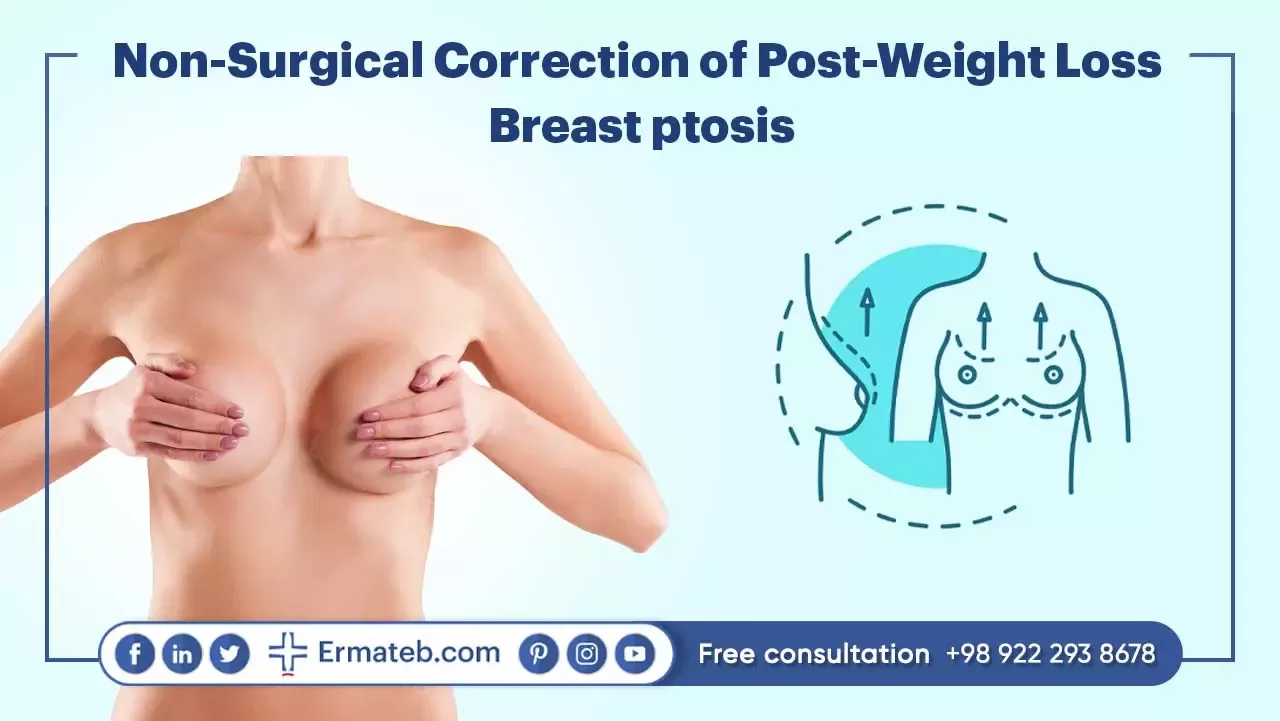
Many people are worried about the possible complications of surgery and prefer non-surgical methods for breast lifting. For women who are not ready for or do not want to undergo surgery, non-surgical options help improve the appearance of sagging and deflated breasts.
Although nonsurgical breast lifts are not as effective as conventional surgery, they are still worth consideration to perk up your breasts to some extent without surgery. The following are some nonsurgical breast lift procedures to consider when dealing with post-weight loss breast sagging:
The BodyTite device emits radiofrequency energy deep into the skin o stimulate collagen production. More collagen production firms the skin and lifts the breasts to a more natural position. A scarless breast lift with the BodyTite instrument includes the application of an electrode to the desired area and placing a cannula under the skin, which will work as one to send the RF energy into the tissue.
These treatments use energy to stimulate collagen production in the skin, tightening and lifting sagging breasts. Increased collagen production can slightly increase skin elasticity in the chest area, but the results would be temporary, and repeated treatments are necessary to see any visible results. Thus, this procedure is not as effective as surgical options.
This method was initially introduced as a form of muscle injury treatment and targets the chest muscles. Using a handheld device, a surgeon focuses electric pulses on the muscles surrounding the breasts, leading to more toned muscles and lifting the breasts.
Thermage is a type of collagen-stimulating procedure, using radio waves to help tighten the protein fibers within the skin. The device called ThermaCool helps deliver radio waves to deeper skin layers, resulting in tighter skin. However, given the temporary results of this procedure, it should be repeated.
The Renuvion/J-Plasma device enables less invasive tightening, promoting skin contraction and the production of new collagen. There are some minimal results immediately with longer-acting results taking several months by the development of the new collagen.
A vampire breast lift (VBL) aims to slightly lift your breasts, similar to that of wearing a push-up bra. This procedure can give the appearance of a lift through increased blood circulation along with less noticeable wrinkles and scars.
The results are evident gradually within a few months, with the overall results lasting a couple of years. This method should not be used in pregnant or breastfeeding women or those with a history of breast cancer.
Botox injections relax the muscles underneath the skin, helping to create a smoothing effect on the skin’s surface. Breast filler injections can add volume to the breasts using injectable materials such as hyaluronic acid. However, the results are temporary and may require repeat injections.
Other injections typically used for the face, including hyaluronic acid (HA)-based dermal fillers, such as Juvéderm and Restylane, are also employed for the breast area. Although While not invasive, cosmetic fillers aren’t considered go-to treatments for the breast area due to a lack of long-term studies on their efficacy.
Thread lifting, often called a “feather lift,” pulls the breasts upward from the inside via small barbed threads inserted beneath the skin. Once the bruising and swelling fade, the breasts will become subtly perkier for 1 to 2 years.
These procedures are temporary and need to be reapplied regularly.
Finally, never forget that a new bra may be helpful in lifting and supporting the breasts. Although a new underwire set will not replace the lost volume, replacement of the ill-fitted bra with the right size will be effective.
Also Read: Best Bra After Breast Augmentation

It is almost impossible to restore the original size and shape of the breasts when some weight is lost, but certain measures can be taken to improve the lift and strength of the bust.
One of the natural remedies is to exercise the fibrous connective tissue and muscles beneath the breasts to improve the overall appearance of the chest.
A healthy diet and healthy lifestyle decisions also contribute to feeding and nourishing your skin and keeping it healthy, strong, and resilient for many years. Drinking enough water during the day and staying hydrated is also critical because it keeps skin strong and improves the overall firmness and strength of the breast tissue.
Posture is another influencing factor, which can cause the breasts to hang by their own weight if not kept correctly, putting more pressure and tension on the breast tissue and leading to more droopy breasts.
It is, therefore, necessary to keep the back straight and the shoulders back for even distribution of the weight and protection of the breasts against sagging.
The above natural ways combined with the following activities can lead to more desirable results after losing weight.
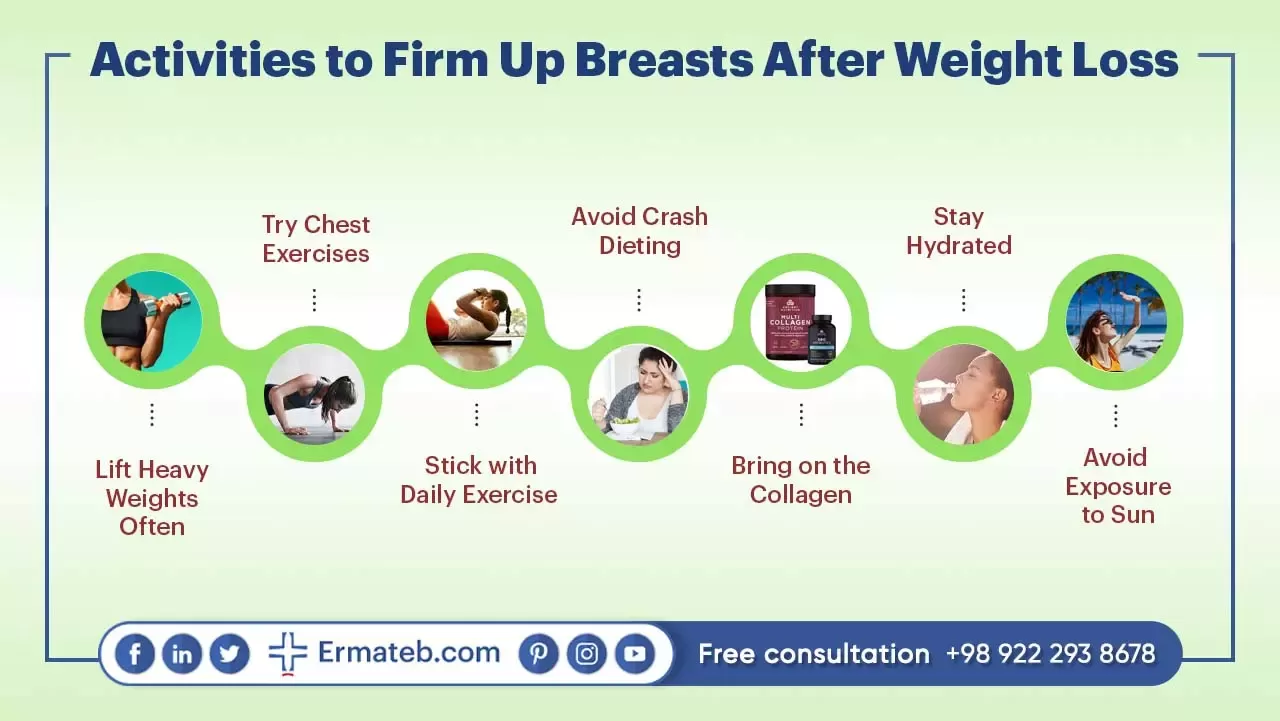
While the majority of breast sagging after weight loss cannot be avoided, there are several activities that can slightly reduce the look of droopy breasts, some of which are as follows:
As there are many benefits of weightlifting, in addition to ensuring an overall firmer look, regular weight lifting can increase metabolism and strengthen bones and muscles.
Although chest exercises cannot completely deal with sagging breasts, they facilitate the improvement of their overall appearance. Some useful exercises include Barbell Bench Press, Chest Fly, Push-ups,
Start off with daily exercise that helps improve overall calorie burn and will contribute to weight loss and skin firmness, particularly for breast skin.
Moderate-intensity activities such as jogging, brisk walking, dance classes, hiking, and cycling for at least 150 minutes per week can lead to optimal health. Regular resistance training also improves metabolism and leads to a firm skin.
Crash diets and quick weight loss are not healthy or sustainable, resulting in saggy breasts. It is important to avoid such diets and nourish the body with plenty of nutrients instead.
Collagen Supplements, protein powders, and skin-loving vitamins might reduce saggy chest skin when you lose weight.
Hydration makes skin healthier and smoother than the dehydrated one.
Exposure to sun dries the skin and leads to more wrinkles.
You’ll probably have smaller breasts after weight loss, but the shrink factor can be minimized in several ways, including the above, in addition to supporting the breasts from inside with strength training, proper skin care, using a well-fitted bra, surgical and non-surgical breast lifts, etc.
After massive weight loss, many men and women prefer to have plastic surgery and improve the appearance of their breasts. Similar to different body parts, the changes seen in the breasts are often evident in clothing.
As not only can losing weight help individuals look and feel better overall, but there are also numerous health benefits obtained by weight loss. For many post-weight loss people, nevertheless, droopy or sagging skin is a disappointing complication that prevents them from reaching their desired goals.
Fortunately, if you are not satisfied with your sagging or droopy breasts after weight loss, you can discuss options for medical treatment with your doctor to achieve the desired results.



